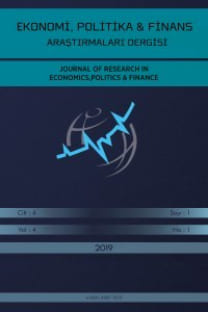Yalın Bir Bakış Açısıyla Kurumsal Hazine Operasyonlarının Optimizasyonu
Yalın Yönetim, Kurumsal Hazine, Finansal Performans
The Optimization of Corporate Treasury Operations from a Lean Perspective
Lean Management, Corporate Treasury, Financial Performance,
___
- Ahlström, P. (1998). Sequences in the implementation of lean production. European Management Journal, 18(3), 327-334. https://doi.org/10.1016/S0263-2373(98)00009-7
- Anderson, S. (2002). Improvement corner: Poka-Yoke…mistake-proofing as a preventive action. The Informed Outlook Reprint, 7(3). Retrieved from http://asq.org/pub/informed
- Blach, J., Kosmala, M., Gorczynska, M., & Dos, A. (2014). Innovations in liquidity management - The potential of corporate treasury. Journal of Economics and Management, (18), 209-224. Retrieved from http://yadda.icm.edu.pl/yadda/element/bwmeta1.element.ekon-element-issn-1732-1948
- Dudek-Burlikowska, M., & Szewieczek, D. (2009). The Poka-Yoke Method as an improving quality tool of operations in the process. Journal of Achievements in Materials & Manufacturing Engineering, 36(1), 95-102. Retrieved from http://jamme.acmsse.h2.pl/
- Fawaz, A. A., & Rajgopal, J. (2007). Analyzing the benefits of lean manufacturing and value stream mapping via simulation: A process sector case study. International Journal of Production Economics, 107(1), 223-236. https://doi.org/10.1016/j.ijpe.2006.09.009
- Ishikawa, K. (1985). What is total quality control? The Japanese way. Michigan: Prentice-Hall.
- Kocakulah, M. C., & Upson, J. (2004). Lean manufacturing: Selected financial performance of recognized lean manufacturers. International Business & Economics Research Journal, 3(12), 9-20. https://doi.org/10.19030/iber.v3i12.3745
- Lynn, B. C. (2008). Managing the modern treasury. Journal of Corporate Treasury Management, 1(3), 211-218. Retrieved from http://search.ebscohost.com
- Masquelier, F. (2009). Corporate treasury’s role in troubled times. Journal of Corporate Treasury Management, 3(1), 16-21. Retrieved from http://search.ebscohost.com
- Murman, E. (2002). Lean enterprise value: Insights from MIT's lean aerospace initiative. London: Palgrave Macmillan.
- Ohno, T. (1988). Toyota production system: Beyond large-scale production. Portland, Oregon: Productivity Press.
- Polak, P., & Klusacek, I. (2010). Centralization of treasury management. Ukraine: Business Perspectives
- Polak, P., Robertson, D. C., & Lind, M. (2011). The new role of the corporate treasurer: Emerging trends in response to the financial crisis [Special issue]. International Research Journal of Finance and Economics, (78). Retrieved from https://www.internationalresearchjournaloffinanceand economics.com/
- Rooyen, J. H. V. (2002). Emerging role of corporate treasury management in cyber space. South African Journal of Information Management, 4(4), 1-14. https://doi.org/10.4102/sajim.v4i4.187
- Shil, N. C. (2009). Explicating 5S: Make you productive. Interdisciplinary Journal of Contemporary Research in Business, 1(6), 33-47. Retrieved from https://ijcrb.webs.com/
- The Association of Corporate Treasurers. (2018). ACT competency framework. Retrieved from https://www.treasurers.org/competencyframework
- Tugwell, P. (2007). Clean up. Works Management, 16-17. Retrieved from https://engineeringresearch.org
- Williams, S. (2009). The lean toolkit, Part IV. CircuiTree, 22(11), 29. Retrieved from https://pdfs.semanticscholar.org
- Yayın Aralığı: Yılda 4 Sayı
- Başlangıç: 2016
- Yayıncı: Ersan ERSOY
Çin’in Kurumsal Reforma Yönelik Stratejileri: AAYB’nin Kuruluşu ve Gelişimindeki Başarı
Volatilite Endeksleri: Gelişimi, Türleri, Uygulamaları ve TRVIX Önerisi
Niyazi TELÇEKEN, Murat KIYILAR, Eyüp KADIOĞLU
VOLATİLİTE ENDEKSLERİ: GELİŞİMİ, TÜRLERİ, UYGULAMALARI VE TRVIX ÖNERİSİ
Niyazi TELÇEKEN, Murat KIYILAR, Eyüp KADIOĞLU
ABD İşgücü Piyasasında Ücretler ve Göç ilişkisi: Neoklasik Göç Teorisi
CRITIC ve EDAS Yöntemleri İle İş Bankası'nın 2009-2018 Yılları Arasındaki Performansının Analizi
Yalın Bir Bakış Açısıyla Kurumsal Hazine Operasyonlarının Optimizasyonu
Hasan KUAS, Göktuğ Cenk AKKAYA
Türkiye'de Suriyeli Mülteci Entegrasyonu: Zorlukları ve Olanakları
İmalat Sanayinde İhracata Dayalı Büyüme Hipotezinin Geçerliliğinin Test Edilmesi: Türkiye Örneği
